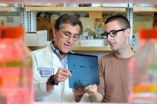(Press-News.org) Positive emotions like joy and compassion are good for your mental and physical health, and help foster creativity and friendship. But people with bipolar disorder seem to have too much of a good thing. In a new article to be published in the August issue of Current Directions in Psychological Science, a journal of the Association for Psychological Science, psychologist June Gruber of Yale University considers how positive emotion may become negative in bipolar disorder.
One of the characteristics of bipolar disorder is the extreme periods of positive mood, or mania. People in the grip of mania also have increased energy, sleep less, and experience extreme self-confidence. At first glance, this may sound good and even desirable. However, during these times of mania, people with bipolar disorder often take dangerous risks, run up their credit card debt, and wreak havoc in marriages. "The fact that positive emotion has gone awry is something unique about bipolar disorder, as almost all other emotional disorders are characterized by difficulties in negative emotions" Gruber says.
Gruber points out that positive emotions are problematic for people with bipolar disorder even when they're not experiencing mania. Gruber has studied people whose bipolar disorder is in remission and found that they still experience more positive emotions than people who have never had bipolar disorder. More positive emotions may not sound like a bad thing, but there are times when these positive emotions aren't appropriate. "In our work, those with bipolar disorder continue to report greater positive emotions whether it's a positive film, very sad film clip of a child crying over his father's death, and even disgusting films involving someone digging through feces" she says. In more recent work Gruber and her colleagues have found they still feel good even if a close romantic partner tells them something sad face to face, they still feel good. "It's rose-colored glasses gone too far."
Clinical psychologists may also be able to use this research to figure out who with bipolar disorder is likely to relapse; people who have a lot of positive emotions, even at inappropriate times, may provide a window into possible early warning signs, Gruber says. In a study of healthy college students who had never been diagnosed with bipolar disorder, Gruber found that those who showed these same high levels of positive emotions that persisted across positive, negative and neutral situations were at higher risk for bipolar disorder.
But not all emotions are alike in bipolar disorder; in fact, they seem to have particular kinds of positive emotions. They report feeling more achievement and self-focused emotions like pride and rewarding feelings like joy. They don't differ social emotions that connect us with others, like love and compassion. "This mirrors early clinical observations and more recent scientific work," Gruber says—that people with bipolar disorder set very high, ambitious goals, are sensitive to rewards, and in periods of mania, some believe they have special powers.
Psychologists should also consider that there are downsides of positive emotions even for people who don't have bipolar disorder, Gruber says. "Although positive emotions are generally good for us, when they take extreme forms or when they're experienced in the wrong context, the benefits of positive emotion begin to unravel," she says. The goal: "experience it in moderation, in the right place and time."
###
For more information about this study, please contact: June Gruber at june.gruber@yale.edu.
Current Directions in Psychological Science, a journal of the Association for Psychological Science, publishes concise reviews on the latest advances in theory and research spanning all of scientific psychology and its applications. For a copy of "Can Feeling Too Good Be Bad? Positive Emotion Persistence (PEP) in Bipolar Disorder," please contact Divya Menon at 202-293-9300 or dmenon@psychologicalscience.org.
Can feeling too good be bad? Positive emotion in bipolar disorder
2011-07-25
ELSE PRESS RELEASES FROM THIS DATE:
Farthest, largest water mass in universe discovered
2011-07-25
An international team of astronomers led by the California Institute of Technology and involving the University of Colorado Boulder has discovered the largest and farthest reservoir of water ever detected in the universe.
The distant quasar is one of the most powerful known objects in the universe and has an energy output of 1,000 trillion suns -- about 65,000 times that of the Milky Way galaxy. The quasar's power comes from matter spiraling into the central supermassive black hole, estimated at some 20 billion times the mass of our sun, said study leader Matt Bradford ...
Shining a light on the elusive 'blackbody' of energy research
2011-07-25
CHESTNUT HILL, MA (July 22, 2011) – A designer metamaterial has shown it can engineer emitted "blackbody" radiation with an efficiency beyond the natural limits imposed by the material's temperature, a team of researchers led by Boston College physicist Willie Padilla report in the current edition of Physical Review Letters.
A "blackbody" object represents a theorized ideal of performance for a material that perfectly absorbs all radiation to strike it and also emits energy based on the material's temperature. According to this blackbody law, the energy absorbed is equal ...
Life scientists use novel technique to produce genetic map for African Americans
2011-07-25
UCLA life scientists and colleagues have produced one of the first high-resolution genetic maps for African American populations. A genetic map reveals the precise locations across the genome where DNA from a person's father and mother have been stitched together through a biological process called "recombination." This process results in new genetic combinations that are then passed on to the person's children.
The new map will help disease geneticists working to map genetic diseases in African Americans because it provides a more accurate understanding of recombination ...
Cellular stress can induce yeast to promote prion formation
2011-07-25
It's a chicken and egg question. Where do the infectious protein particles called prions come from? Essentially clumps of misfolded proteins, prions cause neurodegenerative disorders, such as mad cow/Creutzfeld-Jakob disease, in humans and animals. Prions trigger the misfolding and aggregation of their properly folded protein counterparts, but they usually need some kind of "seed" to get started.
Biochemists at Emory University School of Medicine have identified a yeast protein called Lsb2 that can promote spontaneous prion formation. This unstable, short-lived protein ...
NASA catches 3 tropical cyclones at 1 time
2011-07-25
It's not often that a satellite can capture an image of more than one tropical cyclone, but the GOES-13 satellite managed to get 3 tropical cyclones in two ocean basins in one image today. Bret and his "sister" Cindy are racing through the North Atlantic, while another area tries to develop far to their south. "Cousin" Dora is still a hurricane in the eastern Pacific.
In infrared image taken on July 22 at 0845 UTC (4:45 a.m. EDT), GOES-13 captured Tropical Depression Bret, Tropical Storm Cindy in the north Atlantic and low pressure area associated with a tropical wave ...
Northwest Forest Plan has unintended benefit – carbon sequestration
2011-07-25
CORVALLIS, Ore. – The Northwest Forest Plan enacted in 1993 was designed to conserve old-growth forests and protect species such as the northern spotted owl, but researchers conclude in a new study that it had another powerful and unintended consequence – increased carbon sequestration on public lands.
When forest harvest levels fell 82 percent on public forest lands in the years after passage of this act, they became a significant carbon "sink" for the first time in decades, absorbing much more carbon from the atmosphere than they released. At the same time, private ...
New target found for nitric oxide's attack on salmonella bacteria
2011-07-25
A new target for nitric oxide has been revealed in studies of how it inhibits the growth of Salmonella. This bacterium is a common cause of food-poisoning.
"Nitric oxide is naturally produced in the nose and the gut and other tissues in the body to ward off infection," explained the senior author of the paper, Dr. Ferric Fang. He is a University of Washington (UW) professor of laboratory medicine, microbiology and medicine.
Nitric oxide – not to be confused with nitrous oxide, the laughing gas in dentists' offices – is similar to the preservatives in hotdogs, Fang ...
2 genetic variations predict second cancers after radiation for children with Hodgkin lymphoma
2011-07-25
A genome-wide association study published in the August issue of Nature Medicine has found two tiny genetic variations that can predict which patients with Hodgkin's lymphoma are most likely to develop radiation-induced second cancers years after treatment. Knowing in advance who is at risk could help physicians tailor treatment to reduce the risks for patients who are most susceptible to long-term damage.
Hodgkin's lymphoma is one of the most treatable cancers, with more than 90 percent of patients surviving after a combination of radiation and chemotherapy. But nearly ...
Graphene's 'quantum leap' takes electronics a step closer
2011-07-25
Writing in the journal Nature Physics, the academics, who discovered the world's thinnest material at The University of Manchester in 2004, have revealed more about its electronic properties.
Research institutes and universities around the world are already looking at ways to build devices such as touch-screens, ultrafast transistors and photodetectors.
Now the research from the creators of the material promises to accelerate that research, and potentially open up countless more electronic opportunities.
The researchers, from the universities of Manchester, Madrid ...
Pocket chemistry: DNA helps glucose meters measure more than sugar
2011-07-25
CHAMPAIGN, Ill. — Glucose meters aren't just for diabetics anymore. Thanks to University of Illinois chemists, they can be used as simple, portable, inexpensive meters for a number of target molecules in blood, serum, water or food.
Chemistry professor Yi Lu and postdoctoral researcher Yu Xiang published their findings in the journal Nature Chemistry.
"The advantages of our method are high portability, low cost, wide availability and quantitative detection of a broad range of targets in medical diagnostics and environmental monitoring," Lu said. "Anyone could use it ...





